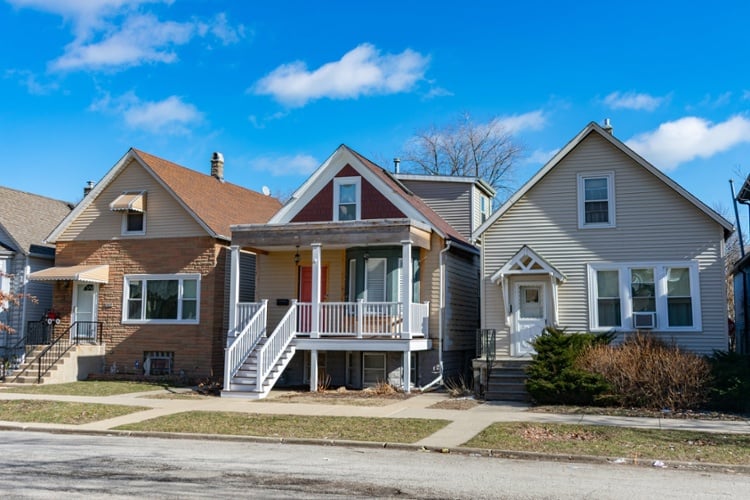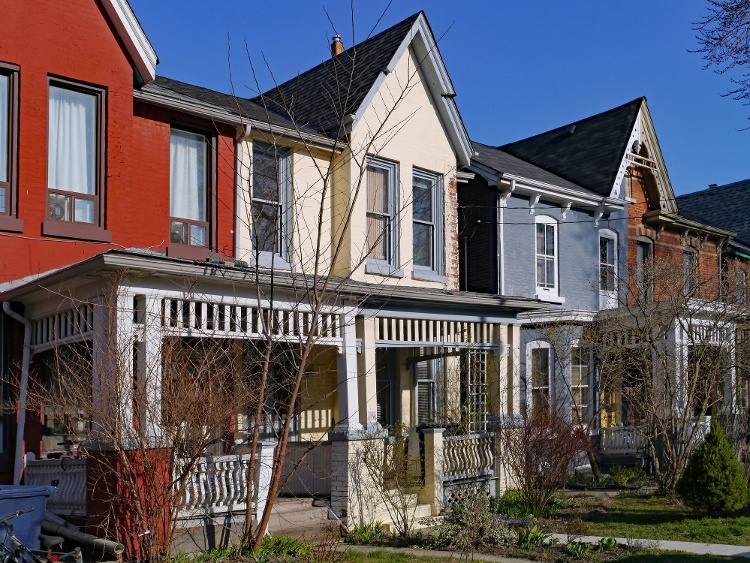You’re probably familiar with the phrase “cash cow.”
It’s used to describe real estate that generates a significant amount of money compared to the purchase price and cost of ownership.
Cash cow real estate is most often found in Class C property.
This property type isn’t right for every investor, but if your investment strategy focuses on cash flow, keep reading to learn if Class C property is right for you.
The Four Real Estate Property Classes
Real estate classes provide a general way of ranking property from good to bad, or from least risky to most risky. There are four real estate property classes:
- Class A
- Class B
- Class C
- Class D
Back in school you probably had A students, B students, etc. Real estate property classifications work the same way. For example, a Class A property is considered better and less risky and a Class B, while Class B is better and less risky than Class C real estate.
Most investors only focus on the first three classes.
Class D property is attractive to investors with an extremely high risk tolerance and access to large amounts of capital who like speculating on a high level of return. This type of real estate has been neglected year after year, requires extensive repairs and updating, and is often vacant or occupied by squatters.
For the remainder of this article, we’ll focus on the first three: A, B, and C.
What Makes a Property Class A, Class B, or Class C?
Although there are no standards in the real estate industry used to classify property, there are several guidelines that investors can follow to understand if a property is Class A, Class B, or Class C:
- Age
- Condition
- Location
- Amenities
- Tenants
- Cash flow
- Appreciation
Similar to cap rates, real estate classification should only be used when comparing property in the same market or submarket.
In the same way that a 4% cap rate might be great in one market but horrible in another, a Class A building in Tucson could easily be rated as a Class C property in Los Angeles. So, if you’re told that a house is Class B, be sure to ask the seller what ranking criteria they’re using.
It’s also important to note that property classes can also differ when comparing property types, like single-family vs multifamily vs commercial real estate.
The main reason investors buy rental property is for the cash flow stream generated. If the cash flow becomes less predictable, the risk of investing in the property increases.
Real estate classes allow an investor to quickly understand where a specific property lies along the risk and reward line.
For example, because Class A property is newly built, operating expenses will be lower and the tenant quality better. There’s also less risk of the cash flow stream being interrupted. But in exchange for less risk, property prices are higher and NOIs (net operating incomes) are lower, which in turn create low cap rates.
Class C real estate is on the opposite end of the risk and reward spectrum. Although there’s more risk, there’s also the potential for a greater reward when the increased risk is minimized.
What is Class C Real Estate?
Class C real estate is on the opposite end of the risk and reward spectrum. While it doesn’t offer the same balanced blend of risk and reward that Class B real estate does, Class C property can be a good match for investors who are willing to accept more calculated risk in exchange for a greater reward.
Because Class C housing is usually located in lower income or neglected areas, the amount of appreciation is low and sometimes nonexistent. However, Class C rental properties are known for the large amount of cash flow they produce, earning the nickname “cash cow.”
Characteristics of Class C Properties
The following characteristics of Class C property will help to explain why this grade of rental property can produce large amounts of cash flow without increasing in value.
1. Age
Houses are generally between 20 and 30 years old and usually described as a ‘basic’ place to live. Class C property usually remains Class C, even as the property gets older and more new homes are built. That’s because new construction is usually targeted toward the luxury buyer and renter market segments.
2. ConditionFinishings and fixtures are below-average and outdated. Property normally has deferred maintenance and may require additional capital investment to replace the roof or HVAC system, or update mechanical systems such as plumbing and electric.
3. Location
Neighborhoods are lower income areas with neighborhood ratings of 2 to 3 stars. School districts are below average and crimes such as vandalism and petty theft can be high.
4. Amenities
Basic convenience stores and businesses such as pawn shops and check cashing outlets serving a lower-income client base are often found in neighborhoods with Class C real estate.
Major shopping malls and entertainment centers may be a distance away, with tenants in urban Class C rental properties depending on the use of public transportation.
5. Tenants
Class C tenants are usually lower income or Section 8 renters. Tenant turnover and bad debt expense is higher. However, some real estate investors like Class C rental property because they feel the tenant has nowhere else to go.
Because of the property age and tenant quality, maintenance and repair costs are also higher, although the increased operating expenses are offset by a healthier cash flow.
In an economic downturn, middle-income tenants in Class B property may relocate to Class C due to a job loss or an effort to save money.
6. Cash flow
Class C property has a lower acquisition price and a higher level of rental income relative to the purchase price, which creates a relatively solid and consistent cash flow stream. Even with a higher level of repair expense, NOI (net operating income), cap rates, and overall yields in Class C real estate can be greater than Class B or A.
In order to consistently generate a high level of cash flow in Class C rental property, management needs to be much more hands-on. Using a property management company experienced with Class C real estate and tenants can help keep the property from being vandalized and tenant theft at a minimum.
7. Appreciation
Investors buy Class C rental property for the cash flow it can produce, not for appreciation. Because of the age and location of Class C real estate, there is little likelihood for market value to significantly increase.
On the other hand, there’s also little chance of the market value of a Class C property going down. That’s because builders and real estate rehabbers focus on the Class B and A types of housing, which helps to keep supply and demand of Class C rental property in balance.
8. Value add
Generally speaking, Class C isn’t the place to look for value-added real estate investments. Because of the characteristics of the neighborhood and tenants, spending money upgrading a Class C property may not result in higher rents or increased property market value.
9. Financing
Financing Class C real estate is more difficult than Class B or A, especially if the property has a significant amount of deferred maintenance. Interest rates are higher and lenders expect borrowers to maintain a higher level of vacancy reserves to ensure funds are available if tenant turnover or repair costs are greater than anticipated.
However, because Class C rental property is often the most affordable housing in a market, real estate investors may qualify for various local and state incentives. One example is the LIHTC or Low-Income Housing Tax Credit. The federal program is administered by each state and provides tax credits and deductions for investors who offer their property as affordable housing for lower-income tenants.
How to Find Class C property
One way to look for Class C rental property is on Roofstock's Marketplace.
Searching by property class isn’t available because real estate classes differ from market to market. However, you can conduct your search using a variety of other criteria:
- Property age: From 20 to 30 years or more, with an original construction date of about the year 1990 or older
- Neighborhood rating: One, two, or three stars
- School rating: Rating of 5 or less, with 10 being the best or most exclusive school districts
- Cap rate: Higher than the market average due to the larger amount of net income compared to the lower purchase price of the property
- Section 8: To find turnkey rental property already qualified as affordable housing

Is Investing in Class C Property a Good Idea?
Rental property investors focused solely on cash flow may find that Class C houses are the perfect investment.
Pros of investing in Class C houses
- Cash flow and cap rates on Class C real estate is higher because purchase prices are lower
- Higher level of cash flow lets investors pay down the loan faster
- Tenant turnover can be low in some Class C property because renters have nowhere else to go and can’t afford to buy a house
- Demand for the affordable housing that Class C rentals provide is consistently strong in most markets throughout the U.S.
- Many investors don’t purchase Class C real estate due to the higher level of risk, so there is less competition from other buyers in the Class C category
- An attractive exit strategy with a Class C house is to structure a lease-option with the tenant, allowing them to use part of a slightly higher rent payment to build up their down payment over time
Cons of investing in Class C houses
- Class C real estate doesn’t significantly appreciate in value
- Value add opportunities generally aren’t found in Class C housing
- Property may need significant repairs and capital investment
- Managing a Class C rental property is much more labor intensive and requires a property manager with experience in this real estate class
Final Thoughts
There’s a real estate class for every type of investment strategy: Class A, Class B, and Class C.
Class A property isn’t the cheapest because it’s usually the safest. Class B rental property offers the perfect blend of risk and reward, with a higher NOI and lower purchase price compared to A.
If you’re focused on cash flow – and potentially lots of it – Class C property may be exactly what you’re looking for:
- Class C rental property is often known as a ‘cash cow’ because of the plentiful amounts of cash generated.
- Vacancy rates and repair costs can be higher, although many tenants stay year after year because they have nowhere else to go.
- Buying Class C real estate is cheaper while the need for labor-intensive property management is higher.











